- Compost, Fungus and Mushrooms, Gardening adventures, Hugelkultur, Microbes and Fungi, Other Insects, Perennial vegetables, Permaculture and Edible Forest Gardening Adventures, Pets, Predators, Rain Catching, Seeds, Soil, Water Saving
Polyculture In A Veggie Bed
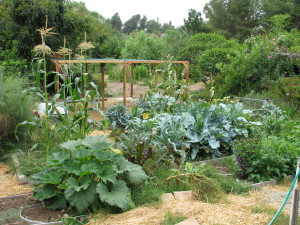 Polyculture is, obviously, the opposite of monoculture, but in permaculture (a lot of -cultures here) it means more than that. The best way to plant in polyculture is to follow the guidelines for a plant guild . A plant guild is how plants arrange themselves in nature so that each fulfills a niche. The variety of plants aren’t competing for the same nutrients and are delivering something other plants need; i.e. shade, nutrients, root exudates, leaf drop, soil in-roads via deep tap roots, etc.
Polyculture is, obviously, the opposite of monoculture, but in permaculture (a lot of -cultures here) it means more than that. The best way to plant in polyculture is to follow the guidelines for a plant guild . A plant guild is how plants arrange themselves in nature so that each fulfills a niche. The variety of plants aren’t competing for the same nutrients and are delivering something other plants need; i.e. shade, nutrients, root exudates, leaf drop, soil in-roads via deep tap roots, etc.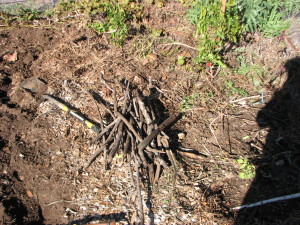
By burying sticks in planting holes you are helping feed the soil and hold water. When planting veggies here at Finch Frolic Garden I often mix up a handful of vegetable, herb and flower seeds that fulfill the plant guild guidelines and plant them all in one area. They come up in a mix of heights, colors, shapes and scents to fool bugs. The result is like a miniature forest.

A merry mixture of vegetables, herbs and flowers in a mature bed. However that sort of wild designed planting has its drawbacks. Harvesting is more time consuming (although more fun, like a treasure-hunt). Many people find peace in looking at rows of vegetables, and peace is valuable.
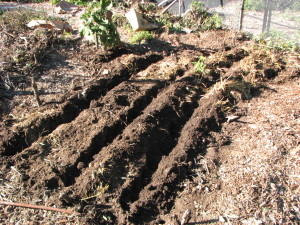
We disturb the soil as little as possible, and pull the soil back for potatoes. You can plant polyculture in rows as well. Just plant each row with a different member of the plant guild, and you’ll achieve a similar effect with insect confusion, and with nutrient conservation.
In this small, slightly sunken bed (we are in drylands so we plant concave to catch water), we planted rows of three kinds of potatoes, two kinds of shallots, a row each of bush beans, fava beans, parsnips, radish and carrots.
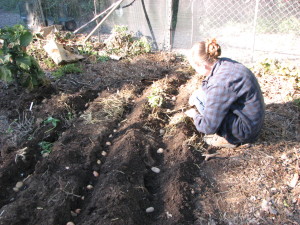
Miranda planting potatoes and shallots before the smaller seeds go in. We covered the bed with a light mulch made from dried dwarf cattail stems. This sat lightly on the soil and yet allowed light and water penetration, giving the seedlings protection from birds and larger bugs.
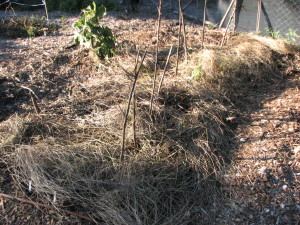
This light, dry mulch worked perfectly. Since cattails are a water plant, there are no worries about it reseeding in the bed. The garden a couple months later. Because we had a warm and rainless February (usually our wettest month), our brassicas headed up rather than produced roots and only a few parsnips and carrots germinated. However our nitrogen-fixing favas and beans are great, our ‘mining’ potatoes are doing beautifully and the shallots are filling out well.
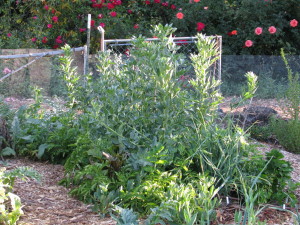
Every plant accumulates nutrition from the air and soil, and when that plant dies it delivers that nutrition to the topsoil. In the case of roots, when they die it is immediate hugelkultur. Without humans, plants drop leaves, fruit and seeds on the ground, where animals will nibble on them or haul them away but leave juice, shells and poo behind. When the plant dies, it dies in place and gives back to the topsoil. When we harvest from a plant we are removing that much nutrition from the soil. So when the plants are through producing, we cut the plants at the soil surface and leave the roots in the ground, and add the tops back to the soil. By burying kitchen scraps in vegetable beds you are adding back the sugars and other nutrients you’ve taken away with the harvest. It becomes a worm feast. Depending upon your climate and how warm your soil is, the scraps will take different lengths of time to decompose. Here in San Diego, a handful of food scraps buried in January is just about gone by February. No fertilizer needed!
- Animals, Bees, Compost, Fungus and Mushrooms, Gardening adventures, Health, Heirloom Plants, Hugelkultur, Microbes and Fungi, Natives, Other Insects, Perennial vegetables, Permaculture and Edible Forest Gardening Adventures, Rain Catching, Recycling and Repurposing, Reptiles and Amphibians, Seeds, Soil, Water, Water Saving, Worms
Plant Guild #9: The Whole Picture
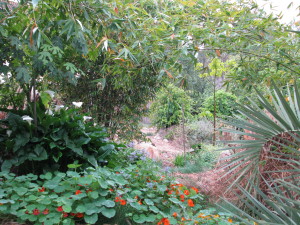 When set in motion the many parts of a plant guild will create a self-sustaining cycle of nutrition and water. By understanding the guild template and what plants fit where, we can plug in plants that fulfill those roles and also provide for us food, building materials, fuel and medicine as well as beauty.
When set in motion the many parts of a plant guild will create a self-sustaining cycle of nutrition and water. By understanding the guild template and what plants fit where, we can plug in plants that fulfill those roles and also provide for us food, building materials, fuel and medicine as well as beauty.Plant the appropriate plants for where you are placing them, for your soil and water use, and stack them in a guild with compatible plants that you can use. The ground will be covered by a foliar density that will keep grasses and other weeds at bay and provide excellent habitat for a full range of animals and insects. By stacking plants in a guild you are bringing life and abundance back to your garden.
Does it still sound so complicated? Rather than try to learn the roles of all the plants in the world, start small. Make a list of all the plants you want to plant. List them under food bearing, culinary/medicinal herb, craft/building material, and ornamental. Then read up on those plants. What size are they at maturity? Do they need full sun, partial or full shade? If trees, do they have an upright growth so you may plant under them (stonefruit), or do they like to have their roots covered and don’t like plants directly under them (citrus and avocado)?
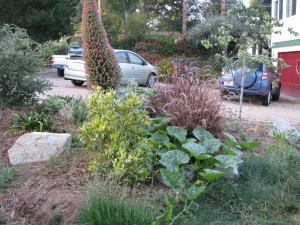
Citrus doesn’t like plants under its canopy, but does like plants outside its dripline. Are they annuals, perennials or biennials? What is their growth habit: sprawling, rooting where they spread, upright bushy, do they need support and can they cling or do they need to be tied to a support?
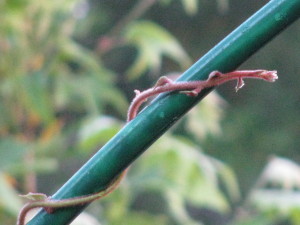
Will the plant twine on its own? Do they require digging up to harvest? Do they fix nitrogen in the soil? Do they drop leaves or are they evergreen? Are they fragrant? When are their bloom times? Fruiting times? Are they cold tolerant or do they need chill hours? How much water do they need? What are their companion plants (there are many guides for this online, or in books on companion planting.)
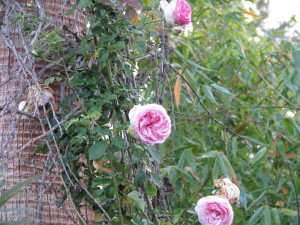
Do vines or canes need to be tied to supports? As you are acquainting yourself with your plants, you can add to their categorization, and shift them into the parts of a plant guild. Yes, many plants will be under more than one category… great! Fit them into the template under only one category, because diversity in the guild is very important.
Draw your guilds with their plants identified out on paper before you begin to purchase plants. Decide where the best location for each is on your property. Tropical plants that are thirsty and don’t have cold tolerance should go in well-draining areas towards the top or middle of your property where they can be easily watered. Plants that need or can tolerate a chill should go where the cold will settle.
Once it is on paper, then start planting. You don’t have to plant all the guilds at once… do it as you have time and money for it. Trees should come first. Bury wood to nutrify the soil in your beds, and don’t forget to sheet mulch.
Remember that in permaculture, a garden is 99% design and 1% labor. If you think buying the plants first and getting them in the ground without planning is going to save you time and money, think again. You are gambling, and will be disappointed.
Have fun with your plant guilds, and see how miraculous these combinations of plants work. When you go hiking, look at how undisturbed native plants grow and try to identify their components in nature’s plant guild. Guilds are really the only way to grow without chemicals, inexpensively and in a way that builds soil and habitat.
You can find the rest of the 9-part Plant Guild series here: Plant Guilds: What are they and how do they work? The first in a series. , Plant Guild #2: Canopy , Plant Guild #3: Sub-Canopy , Plant Guild #4: Nitrogen-Fixers, Plant Guild #5: Mining Plants, Plant Guild #6: Groundcovers, Plant Guild #7: Vines, Plant Guild #8: Insectiaries .
- Animals, Bees, Gardening adventures, Heirloom Plants, Natives, Other Insects, Perennial vegetables, Permaculture and Edible Forest Gardening Adventures, Seeds
Plant Guild #8: Insectiaries
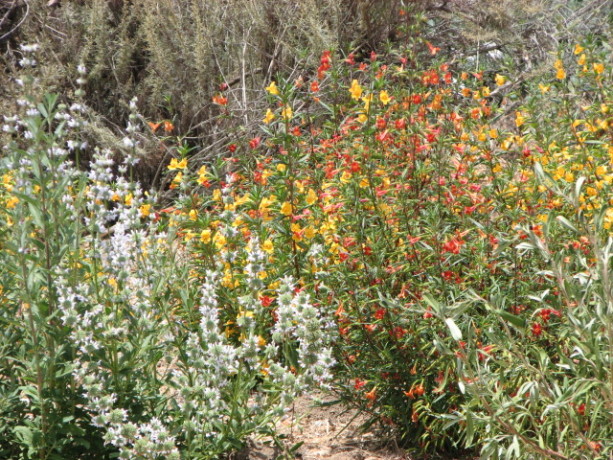
California native sage and penstemon make great insectiaries. Insectiaries are plants which attract lost of pollinators to the rest of your plant guild. We’re not just talking honey bees. Actually, what Americans raise and call honey bees, any bees from the genus Apis which are colonial honey-producers, are all European. Of course there are also the African honey bees which are loose in America, but their ‘hotness’ – their radical and violent protective measures – are not welcome. There are no native honey bees in North America.
What we do have are hundreds of species of bees, wasps and flies which are native and which do most of the pollenization in non-poisoned gardens and fields. Here in Southern California where everything is smaller due to the low rainfall we have wasps, flies and bees which range in size from the inch-long carpenter bees to those the size of a freckle. A small freckle. In fact the best native pollinator we have is a type of hover fly that is about the size of a grain of rice.

Hoverflies (Family Syrphidae) are one of our best pollinators. My daughter Miranda hosts our Finch Frolic Garden Facebook page where she has posted albums of animals and insects found here, with identifications along with the photos so that you can tell what is the creature’s role in the garden (you don’t need to be a member of Facebook to view it).
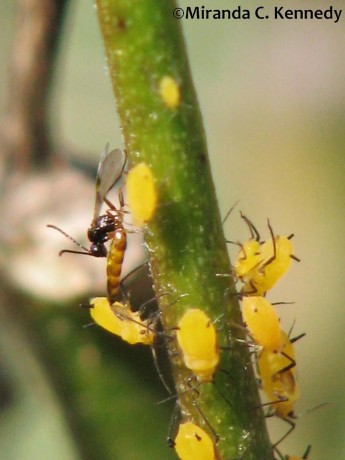
“This photo is of a minute parasitoid wasp (likely Lysiphlebus testaceipes) which preys on aphids. The aphids here are Oleander Aphids (Aphis nerii), which infest our milkweed bushes.” Miranda Kennedy We notice and measure the loss of the honeybee, but no one pays attention to the hundreds of other ‘good guys’ that are native and do far more work than our imports. Many of our native plants have clusters of small flowers and that is to provide appropriate feeding sites for these tiny pollinators. Tiny bees need a small landing pad, a small drop of nectar that they can’t drown in, and a whole cluster of flowers close together because they can’t fly for miles between food sources.
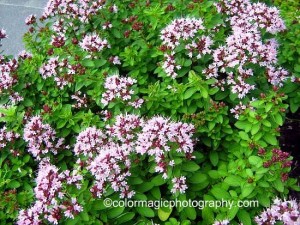
Oregano doesn’t spread as much as other mints do, and can be kept in check by harvesting. Look closely at the blooms in summer and you’ll see lots of very tiny insects pollinating! If you’ve read my other Plant Guild posts, you’ve already familiar with this, but here it goes again. You’ve heard of the ‘Three Sisters’ method of planting by the Native Americans: corn, beans and squash. In Rocky Mountain settlements of Anasazi, a fourth sister is part of that very productive guild, the Rocky Mountain bee plant (Cleome serrulata). Its purpose was as an insectiary.
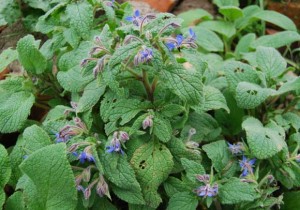
Borage is edible, medicinal, lovely and reseeds. So planting native plants that attract the insects native to your area is just as important as planting to attract and feed honey bees. Many herbs, especially within the mint and sage families, produce flowers that are enjoyed by most sizes of insects and are useful as food or medicine as well.

You’ll remember our old friend comfrey, which is also a mining plant and great green fertilizer! It also is a dining room for bumblebees. If you like flowers, here’s where you can possibly plant some of your favorites in your guild and not feel guilty about it! Of course, aesthetics is important and if you aren’t enjoying what is in your garden, you aren’t doing it right, so plant what makes you happy. As long as its legal.
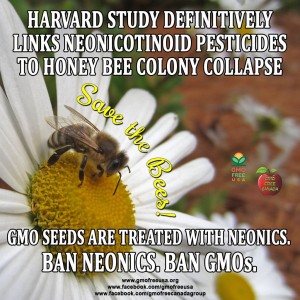 Of course be sure to grow only non-GMO plants, and be ESPECIALLY sure that if you are purchasing plants they are organically raised! Although large distributors such as Home Depot are gradually phasing into organics, an enormous amount of plants sold in nurseries have been treated with systemic insecticides, or combination fertilizer/insecticides.
Of course be sure to grow only non-GMO plants, and be ESPECIALLY sure that if you are purchasing plants they are organically raised! Although large distributors such as Home Depot are gradually phasing into organics, an enormous amount of plants sold in nurseries have been treated with systemic insecticides, or combination fertilizer/insecticides. 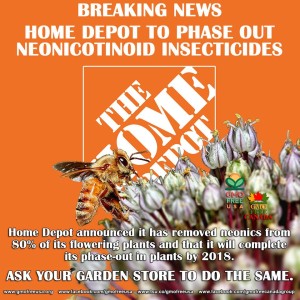 Systemic poisons work so that any insect biting the plant will be poisoned. It affects the pollen and nectar as well, and systemics do not have a measurable life span. They don’t disappear after a month or so, they are there usually for the life of the plant. If your milkweed plants don’t have oleander aphids on them, be wary! If the plants sold as food for pollinators and as host plants don’t have some insect damage to them, beware! They WILL sell you ‘butterfly and bird’ plants, but also WILL pre-treat them will systemic insecticides which will kill the Monarchs and other insects that feed on the plant, and sicken the nectar-sipping birds.
Systemic poisons work so that any insect biting the plant will be poisoned. It affects the pollen and nectar as well, and systemics do not have a measurable life span. They don’t disappear after a month or so, they are there usually for the life of the plant. If your milkweed plants don’t have oleander aphids on them, be wary! If the plants sold as food for pollinators and as host plants don’t have some insect damage to them, beware! They WILL sell you ‘butterfly and bird’ plants, but also WILL pre-treat them will systemic insecticides which will kill the Monarchs and other insects that feed on the plant, and sicken the nectar-sipping birds.  Even those plants marked ‘organic’ share table space in retail nurseries with plants that are sprayed with Malathion to kill white fly, and be sure that the poison drift is all over those organic vegetables, herbs and flowers. Most plant retailers, no matter how nice they are, buy plants from distributors which in turn buy from a variety of nurseries depending upon availability of plants, and the retail nurseries cannot guarantee that a plant is organically grown unless it comes in labeled as such. Even then there is the poison overspray problem. The only way to have untainted plants is to buy non-GMO, organically and sustainably grown and harvested seeds and raise them yourself, buy from local nurseries which have supervised the plants they sell and can vouch for their products, and put pressure on your local plant retailers to only buy organic plants.
Even those plants marked ‘organic’ share table space in retail nurseries with plants that are sprayed with Malathion to kill white fly, and be sure that the poison drift is all over those organic vegetables, herbs and flowers. Most plant retailers, no matter how nice they are, buy plants from distributors which in turn buy from a variety of nurseries depending upon availability of plants, and the retail nurseries cannot guarantee that a plant is organically grown unless it comes in labeled as such. Even then there is the poison overspray problem. The only way to have untainted plants is to buy non-GMO, organically and sustainably grown and harvested seeds and raise them yourself, buy from local nurseries which have supervised the plants they sell and can vouch for their products, and put pressure on your local plant retailers to only buy organic plants.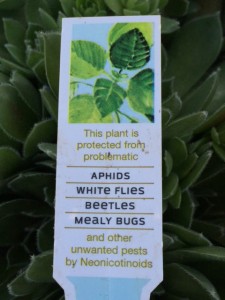
Talk about a sales twist! They don’t mention that it kills EVERYTHING else! When public demand is high enough, they will change their buying habits, and that will force change all the way down the line to the farmers. No matter how friendly and beautiful a nursery is and how great their plants look, insist that they prove they have insecticide-free plants from organic growers (even if they don’t spray plants themselves). Systemic insecticides are bee killers. And wasp and fly killers as well.
Of course many of the other guild members will also attract pollinators, and even be host plants for them as well. With a variety of insectiaries, you’ll receive the benefit of attracting many species of pollinator, having a bloom time that is spread throughout the year, and if a plant is chewed up by the insect it hosts (milkweed by Monarch caterpillars, for instance) there will be other blooms from which to choose.
Placing fragrant plants next to your pathways also gives you aromatherapy as you pass by.
And flowers are pretty. So plant them!
You can find the entire 9-part Plant Guild series here: Plant Guilds: What are they and how do they work? The first in a series. , Plant Guild #2: Canopy , Plant Guild #3: Sub-Canopy , Plant Guild #4: Nitrogen-Fixers, Plant Guild #5: Mining Plants, Plant Guild #6: Groundcovers, Plant Guild #7: Vines, Plant Guild #9: The Whole Picture.
- Animals, Bees, Birding, Gardening adventures, Heirloom Plants, Natives, Other Insects, Perennial vegetables, Permaculture and Edible Forest Gardening Adventures, Predators, Rain Catching, Soil, Water Saving
Plant Guild #7: Vines
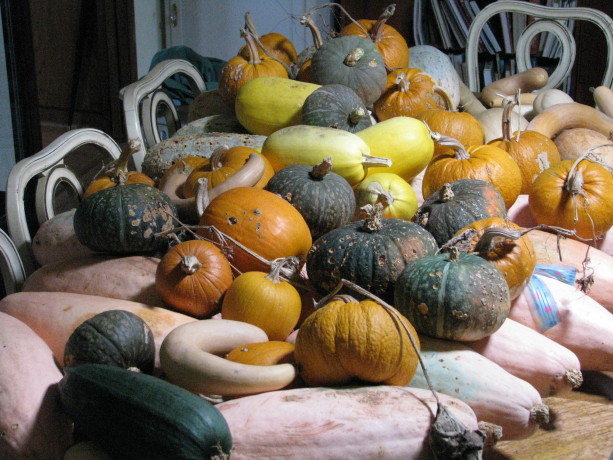
Our varieties of squash several years ago. You may think that vines and groundcover plants are pretty interchangeable, and they can share a similar role. However, as we covered in the Plant Guild #6: Groundcovers these plants do not have to vine, but just cover large spaces close to the ground and coming from a single trunk or stem.
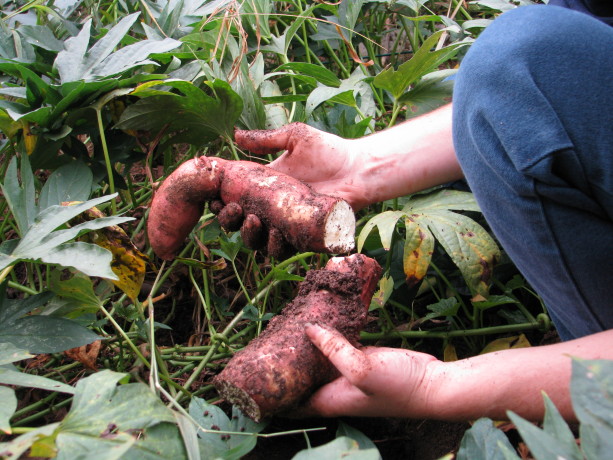
Sweet potatoes and yams make fantastic ground covers. The leaves are edible. Some root in one place, and some spread tubers over a larger area, so choose what is appropriate for digging up your harvest in your guild. They will die of frost. Vines can be large and heavy, small and delicate, perennial or annual. In a food plant guild vines are often food-bearing, such as squash. If you recall the legendary Three Sisters of planting – corn, beans and squash – there are two vines at work here. The corn forms a trellis for the light and grabby bean plant to climb upon (the bean fixing nitrogen in the soil as well as attracting pollinators with its flowers). The squash forms a low canopy all around the planted area. The big leaves keep moisture in, soften the raindrops to prevent erosion and deoxygenation, drop leaves to fertilize the soil, provide a large food crop, and attract larger pollinators. Even more than that, the squash protects the corn from raccoons. These masked thieves can destroy an entire backyard corn crop in a night, just when the corn is ripe. However, they don’t like walking where they can’t see the ground, so the dense squash groundcover helps keep them away.
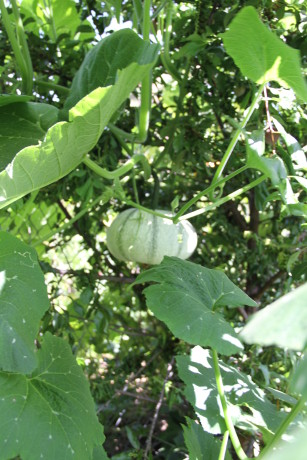
Pipian from Tuxpan squash supported by a plum and a pepper tree. Vines are very important to use on vertical space, especially on trees. With global warming many areas now have extremely hot to scorching sun, and for longer periods. Intense sun will scorch bark on tender trees, especially young ones. By growing annual vines up the trees you are helping shade the trunk while producing a crop, and if the vines are legumes you are also adding nitrogen fertilizer.
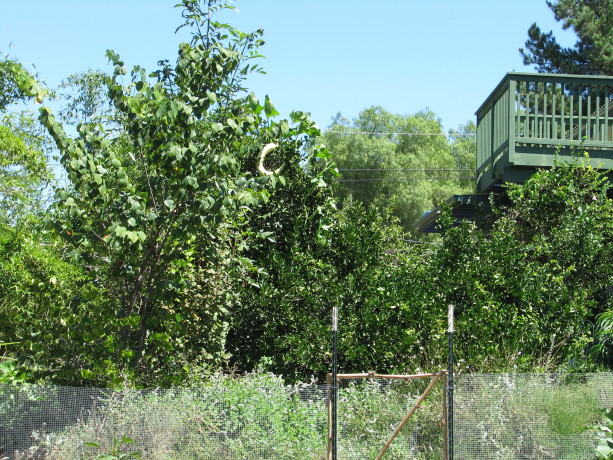
Can you spot the squash in the lime tree? It is crescent shaped and pale. Be sure the weight of the mature vine isn’t more than the tree support can hold, or that the vine is so strong that it will wind its way around new growth and choke it. Peas, beans and sweetpeas are wonderful for small and weaker trees. When the vines die they can be added to the mulch around the base of the tree, and the tree will receive winter sunlight. When we plant trees, we pop a bunch of vining pea (cool weather) or bean (warm weather) seeds right around the trunk. Larger, thicker trees can support tomatoes, cucumbers, melons, and squash of various sizes, as well as gourds. Think about how to pick what is up there! We allowed a alcayota squash to grow up a sycamore to see what would happen, and there was a fifteen pound squash hanging twelve feet above the pathway until it came down in a heavy wind!
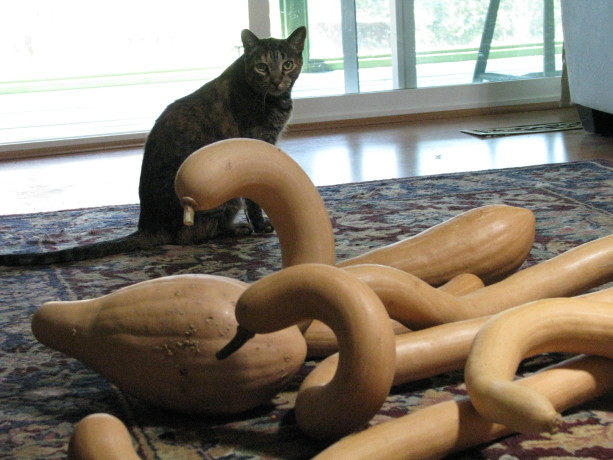
These zuchinno rampicante, an heirloom squash that can be eaten green or as a winter squash, form interesting shapes as they grow. These ‘swans’ and Marina are having a stare-off. Nature uses vertical spaces for vines in mutually beneficial circumstances all the time, except for notable strangler vines. For instance in Southern California we have a wild grape known as Roger’s Red which grows in the understory of California Live Oaks. A few years ago there appeared in our local paper articles declaiming the vines, saying that everyone should cut them down because they were growing up and over the canopy of the oaks and killing them. The real problem was that the oaks were ill due to water issues, or beetle, or compaction, and had been losing leaves. The grape headed for the sun, of course, and spread around the top of the trees. The overgrowth of the grape wasn’t the cause of the problem, but a symptom of a greater illness with the oaks.
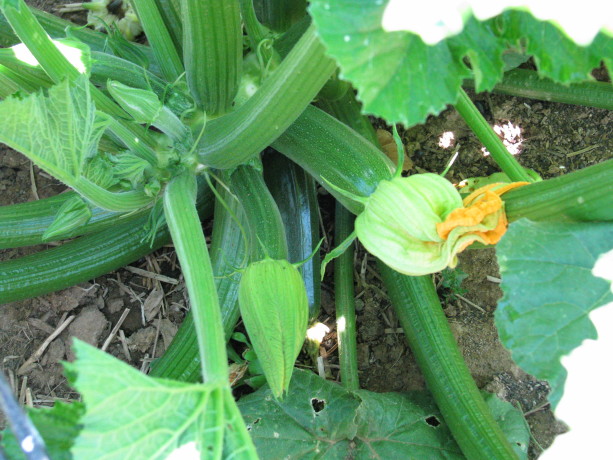
Zucchini! Some vines are not only perennial, but very long-lived and should be placed where they’ll be happiest and do the most good. Kiwi vines broaden their trunks over time and with support under their fruiting stems can be wonderful living shade structures. A restaurant in Corvallis, Oregon has one such beauty on their back patio. There is something wonderful about sitting in the protection of a living thing.
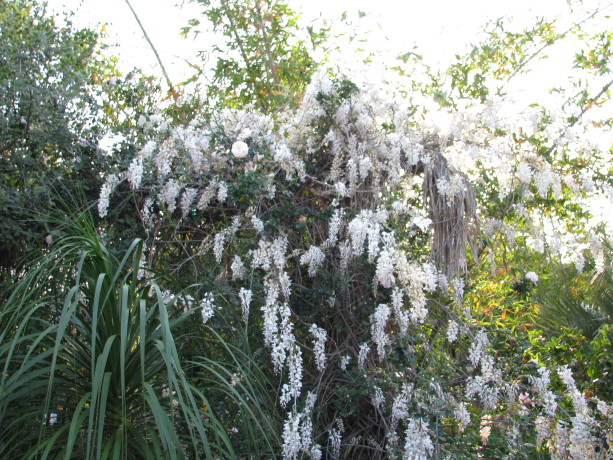
Wisteria chinensis is a nitrogen-fixer with edible flowers (and poisonous other parts), has stunning spring flowers and can make a nice deciduous vine to cover a canopy. It does spread vigorously, but can be trained into a standard, and are fairly drought tolerant when mature. Passionvines can grow up large trees where they can receive a lot of light. Their fruit will drop to the ground when ripe. The vines aren’t deciduous, so the tree would be one where the vine coverage won’t hurt the trunk.
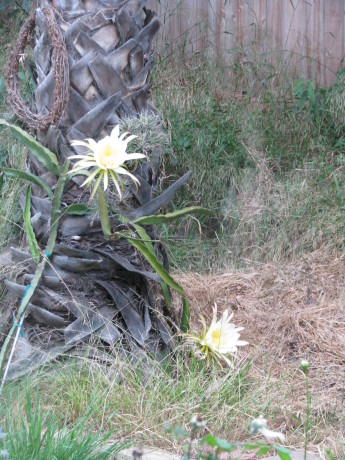
Dragonfruit aren’t exactly a vine, but they can be trained up a sturdy tree. Vines such as hops will reroot and spread wherever they want, so consider this trait if you plant them. Because the hops need hand harvesting and the vines grow very long, it is probably best to put them on a structure such as a fence so you can easily harvest them.
So consider vines as another important tool in your toolbox of plants that help make a community of plants succeed.
Next in the Plant Guild series, the last component, Insectiaries. You can find the entire 9-part Plant Guild series here: Plant Guilds: What are they and how do they work? The first in a series. , Plant Guild #2: Canopy , Plant Guild #3: Sub-Canopy , Plant Guild #4: Nitrogen-Fixers, Plant Guild #5: Mining Plants, Plant Guild #6: Groundcovers, Plant Guild #8: Insectiaries, Plant Guild #9: The Whole Picture.
- Animals, Bees, Birding, Compost, Fungus and Mushrooms, Gardening adventures, Health, Heirloom Plants, Hugelkultur, Microbes and Fungi, Natives, Other Insects, Perennial vegetables, Permaculture and Edible Forest Gardening Adventures, Predators, Rain Catching, Reptiles and Amphibians, Seeds, Soil, Water, Water Saving, Worms
Plant Guild #6: Groundcover Plants

Artichokes are mining plants, but also have a low enough profile to be a groundcover plant. They make excellent chop-and-drop. Flanking are lavender, scented geranium (left), and borage. In most ecosystems that offer easy food for humans, the ground needs to be covered. Layers of leaves, organic matter from animals (poo, fur, carcasses, meal remains, etc.) , dropped branches and twigs, fallen flowers and fruit, and whatever else gravity holds close to the earth, compost to create soil and retain water and protect the soil from erosion and compaction. Areas that don’t have this compost layer are called deserts. If you want to grow an assortment of food for humans, you have to start building soil. Even in desert communities where there are some food plants growing, such as edible cactus, mesquite beans, etc., there is biodiversity on a more microscopic scale than in old growth forests. In deserts the soil needs to absorb what little rain there is and do it quickly before it evaporates, and plants have leaves adapted to have small leaf surfaces so as not to dry out, and there are few leaves to drop. Whereas in areas where there are large forests the weather is usually wetter, tall plants and thick underbrush provide multiple layers of protection both on the plants and when they fall to layer the earth.
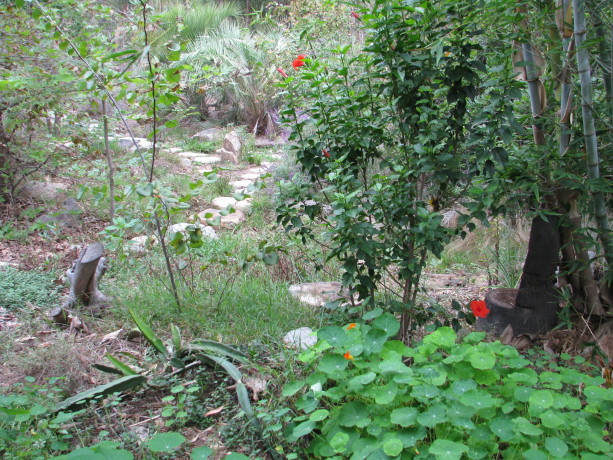
Nasturtium reseeds itself annually, is edible with a bite of hotness, detracts aphids from other plants, and is charming. Don’t let it get away in natural areas, though. A quick way to build soil in plant guilds is to design for plants that will cover the ground. This isn’t necessarily the same groundcover as you would use to cover embankments. For instance, iceplant can be used in a pinch, but it really isn’t the best choice in most plant guilds unless you are in a very dry climate, and your plant guild is mostly desert-type plants: date palm, etc. Annuals can be squash or other aggressive food-producing vines such as unstaked tomatoes. However you don’t need to consider just ground-hugging plants; think sprawling shrubs.
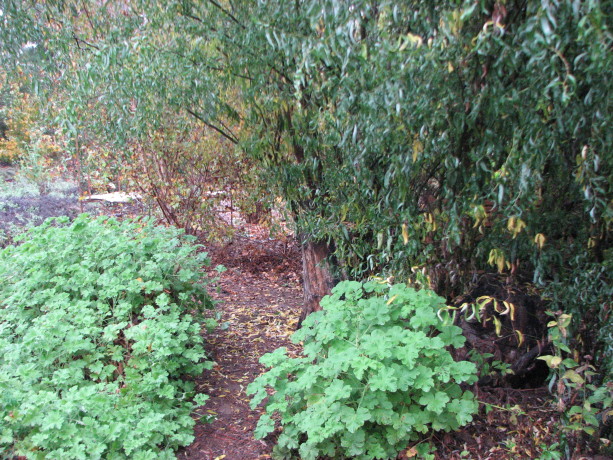
Scented geraniums are a great ‘placeholder plant’. These Pelargoniums (not true geraniums) come in a wide variety of fragrances. We’ve found bird nests in these! When guests tour through Finch Frolic Garden, they often desire the lush foresty-feel of it for their own properties, but have no idea how to make it happen. This is where what I call ‘placeholder plants’ come in. Sprawling, low-cost shrubs can quickly cover a lot of ground, protect the soil, attract insects, often be edible or medicinal, be habitat for many animals, often can be pruned heavily to harvest green mulch (chop-and-drop), often can be pruned for cuttings that can be rooted for new plants to use or to sell, and are usually very attractive. When its time to plant something more useful in that area, the groundcover plant can be harvested, used for mulch, buried, or divided up. During the years that plant has been growing it has been building soil beneath it, protecting the ground from compaction from the rain. There is leave mulch, droppings from lizards, frogs, birds, rabbits, rodents and other creatures fertilizing the soil. The roots of the plant have been breaking through the dirt, releasing nutrients and developing microbial populations. Some plants sprawl 15′ or more; some are very low-water-use. All of this from one inexpensive plant.
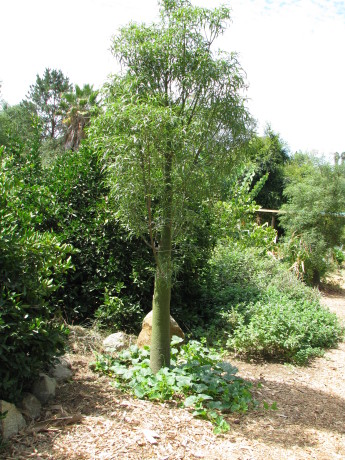
Squash forms an annual groundcover around the base of this euphorbia. Depending upon your watering, there are many plants that fit the bill, and most of them are usable herbs. Scented geraniums (Pelargonium spp.), lavender, oregano, marjoram, culinary sage, prostrate rosemary, are several choices of many plants that will sprawl out from one central taproot. Here in Southern California, natives such as Cleveland sage, quail bush (which harvests salt from the soil), and ceanothus (California lilac, a nitrogen-fixer as well), are a few choices. Usually the less water use the plant needs, the slower the growth and the less often you can chop-and-drop it. With a little water, scented geraniums can cover 10 – 15 feet and you can use them for green mulch often, for rooted cuttings, for attracting insects, for medicine and flavoring, for cut greenery, for distillates if you make oils, etc.
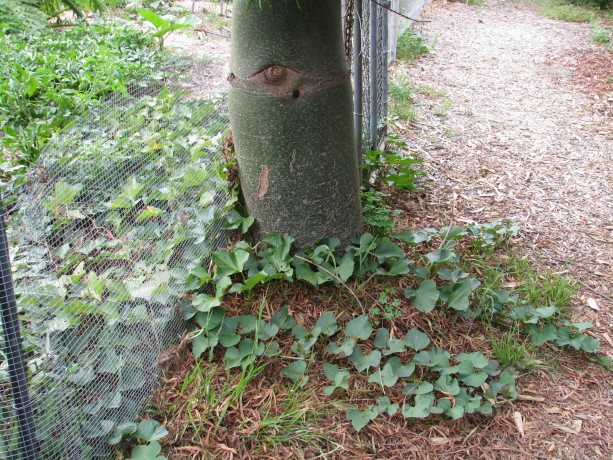
Sweet potatoes make a great ground cover. Choose varieties that produce tubers directly under the plant rather than all along the stems so that you don’t have to dig up your whole guild to harvest. Groundcover plants shouldn’t be invasive. If you are planting in a small guild, planting something spreading like mint is going to be troublesome. If you are planting in larger guilds, then having something spreading in some areas, such as mint, is fine. However mint and other invasives don’t sprawl, but produce greenery above rootstock, so they are actually occupying more space than those plants that have a central taproot and can protect soil under their stems and branches. Here at Finch Frolic Garden, we have mint growing freely by the ponds, and in several pathways. Its job is to crowd out weeds, build soil, and provide aromatherapy. I’d much rather step on mint than on Bermuda grass, and besides being a superb tea herb, the tiny flowers feed the very small bees, wasps and flies that go unsung in gardens in favor of our non-native honeybees (there are no native honeybees in North America).
Here’s a general planting tip: position plants with fragrant leaves and flowers near your pathways for brush-by fragrance. You should have a dose of aromatherapy simply by walking your garden path. Mints are energizing, lavenders calming, so maybe plan your herbs with the pathways you take in the morning and evening to correspond to what boost you need at that time.
Consider groundcover plants and shrubs that will give you good soil and often so much more.
Next up: Vining Plants.
You can find the entire 9-part Plant Guild series here: Plant Guilds: What are they and how do they work? The first in a series. , Plant Guild #2: Canopy , Plant Guild #3: Sub-Canopy , Plant Guild #4: Nitrogen-Fixers, Plant Guild #5: Mining Plants, Plant Guild #7: Vines, Plant Guild #8: Insectiaries, Plant Guild #9: The Whole Picture.
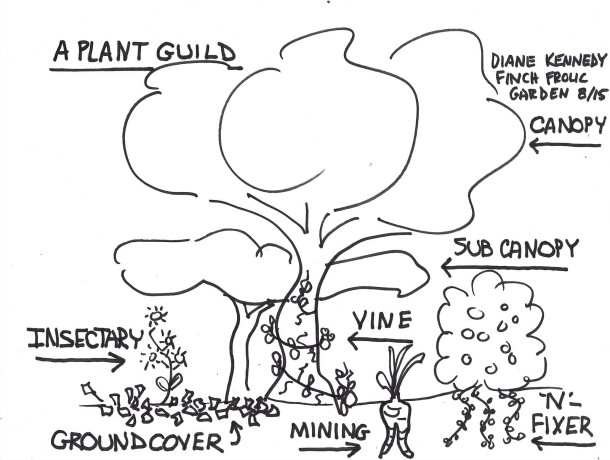
What makes up a plant guild. - Animals, Birding, Compost, Fungus and Mushrooms, Gardening adventures, Hugelkultur, Humor, Microbes and Fungi, Natives, Other Insects, Perennial vegetables, Permaculture and Edible Forest Gardening Adventures, Ponds, Predators, Rain Catching, Reptiles and Amphibians, Seeds, Soil, Water, Water Saving, Worms
Ponds and Potatoes; A Finch Frolic New Year’s Celebration
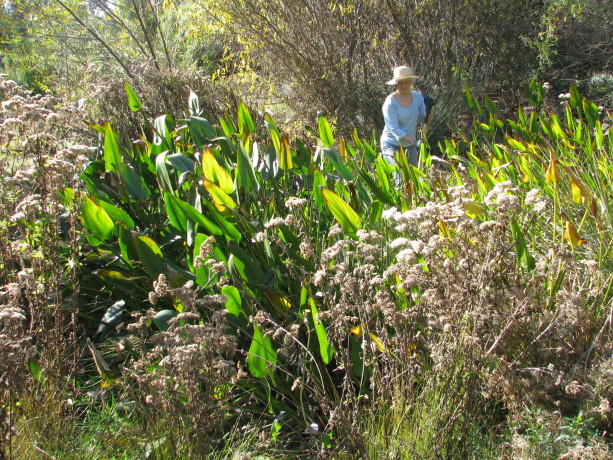 Our sixty degree weather here in Fallbrook, CA , gave us the opportunity to work in our garden. A year ago – 2014 – it snowed on New Year’s Eve. This year the nights are frosty, the days mercifully warmer, and the rain frustratingly rare. Our promised El Nino rains are expected to hit in force within the next couple of months. Weather they do or not, focusing on catching every precious drop in the soil, and protecting the ground from erosion and compaction, is paramount.
Our sixty degree weather here in Fallbrook, CA , gave us the opportunity to work in our garden. A year ago – 2014 – it snowed on New Year’s Eve. This year the nights are frosty, the days mercifully warmer, and the rain frustratingly rare. Our promised El Nino rains are expected to hit in force within the next couple of months. Weather they do or not, focusing on catching every precious drop in the soil, and protecting the ground from erosion and compaction, is paramount.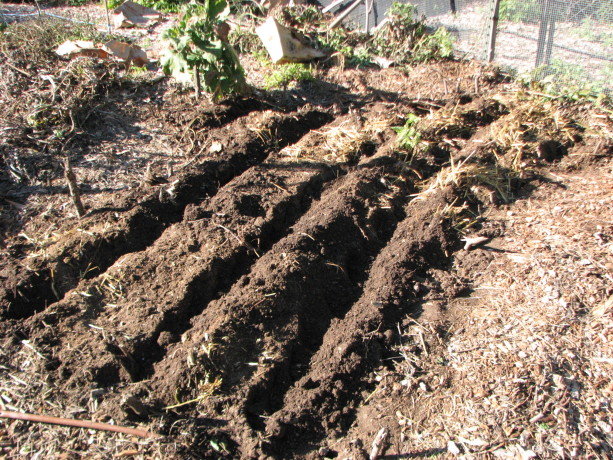
Permaculture in rows. Pretty nice soil, which had been silt from the street a couple of years ago, mixed with chicken straw, topped with leaves. No chemicals! The last day of 2015 Miranda and I spent working one of our vegetable garden beds, and reshaping our kitchen garden. When we redesigned this garden by removing (and burying) the raised beds, hugelkulturing and planting, we made a lovely Celtic design.
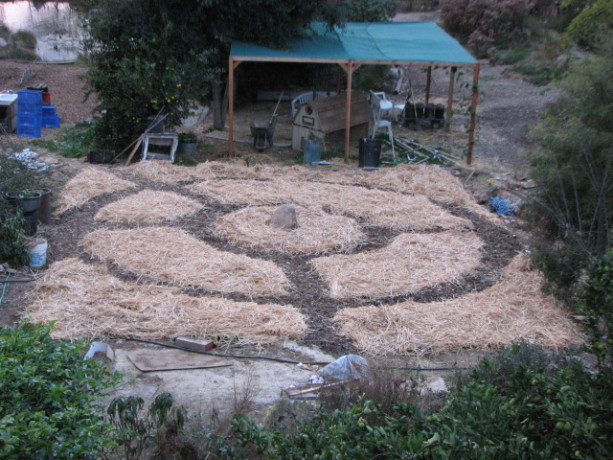
The unplanted kitchen garden newly designed in January, 2013. However the plants just won’t respect the design, so we’ve opted to lessen the pathways, turning the beds into keyhole designs for more planting space. I’ll blog more about that in the future. Because the pathways have been covered in cardboard and woodchips (sheet mulched), the soil below them is in very good shape, not dry and compacted.

How deep do roots grow? This clump of oxalis (sour grass) is white because it was growing without light under the pathway sheet mulch. The corms at the end of the long roots are about 8 inches below the plant. Good soil means deep roots; I’ve never seen this plant have anything but shallow roots. This bed has been home to sweet potatoes and various other plants, so although I try to practice the no-dig method, where you have root vegetables you must gently probe the soil for goodies. We left some of the roots, so sweet potatoes will again rise in this bed.

Miranda planting potatoes and shallots in rows. Between these rows and around the outisde other veggies were planted. We planted in rows. Usually I mix up seeds, but this time I wanted to demonstrate polyculture in row form. We planted three rows of organic potatoes (purchased from Peaceful Valley Organics), with a row of shallots between them. Between the root vegetable rows we planted a row of fava beans, and a row of sugar pod peas. Around the edges Miranda planted rows of bull’s blood beets, Parisienne carrots, and maybe some parsnips. This combination of plants will work together in the soil, following the template of a plant guild. We left the struggling eggplant, which came up late in the year after the very hot summer and has so far survived the light frost.
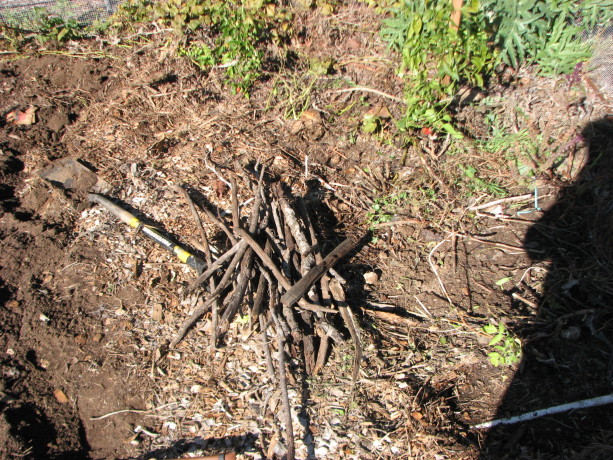
Sticks. So important for the soil. These went in vertically around the planting bed to act both as one type of gopher deterrent (a physical barrier) and also as food and as water retention for the veggies. On top of the bed we strew dead pond plants harvested from our small pond near our house, which will be receiving an overhaul soon (hopefully before the Pacific chorus frogs start their mating season in force). We didn’t water the seeds in, as there is rain predicted in a few days. The mulch on top will help protect the seeds from hungry birds.
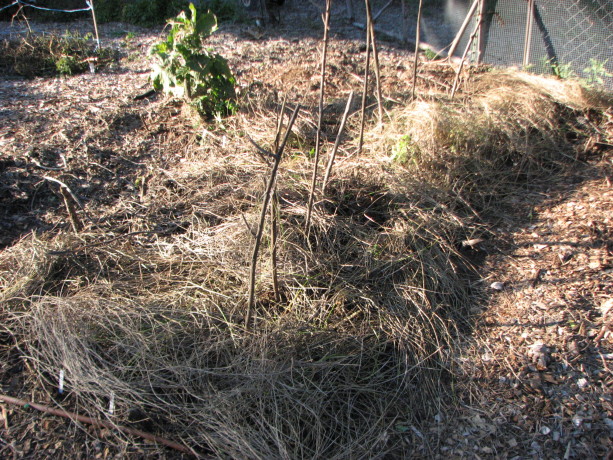
The finished bed topped with dead pond weeds (which don’t have seeds that will grow on dry land!). The sticks are to steady future bush peas. A good way to spend the last day of the year: setting seeds for food in the spring.
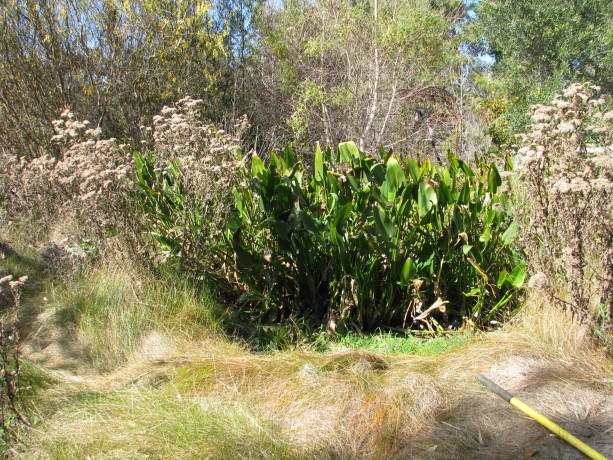
Before: The little pond, which is also a silt basin, almost completely filled by an enthusiastic clump of pickerel. This pond is wonderful habitat for birds, frogs, dragonflies, and so many other creatures, and as a water source for raccoon, possum, coyotes, ducks, and who knows what else that visits in the night. Then on January 1 I decided it was a good opportunity to clear out the excess pickerel that had taken over our lower small pond. With the well off for the winter, and very light rainfall, this pond has gone dry. A perfect opportunity for me to get in there with a shovel, especially knowing that I already had a chiropractor’s appointment set for Monday (!).

Making some headway. The mud was slick and spongy, but not unsafe, and not nearly as smelly as I had anticipated. Pickerel is not a native to San Diego, but it is a good habitat pond plant and it has edible parts. I wasn’t tempted, however. Its roots are thick and form a mat several inches thick hiding rhizomes that are up to an inch in diameter. I’d cut into the mass from several sides, pull the mass out with my gloved hands and throw the heavy thing out of the pond. Its good to be in contact with the earth, in all its forms. I couldn’t think of a better way to use the holiday afternoon.
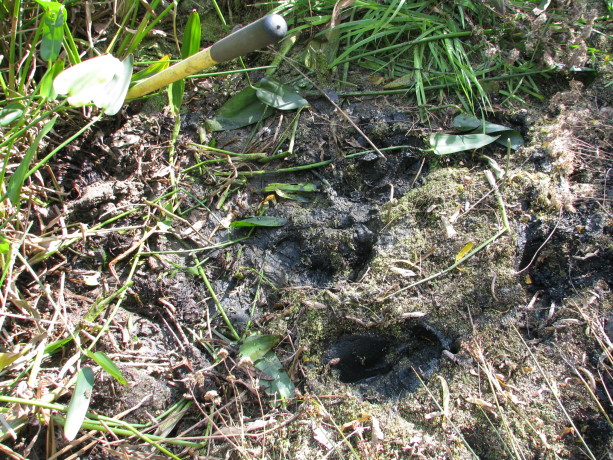
Thick root mass hiding large rhizomes made removal a real exercise. This is why I practice yoga and attend Zumba class with Ann Wade at the Fallbrook Community Center! I moved at least a ton of material in four hours. Just before sunset I decided that I was done. About an hour before that, my body had decided that I was done, but I overrode its vote to finish. I left some pickerel for habitat and looks, and will try to contain it by putting some sort of a physical barrier along the roots, such as urbanite.
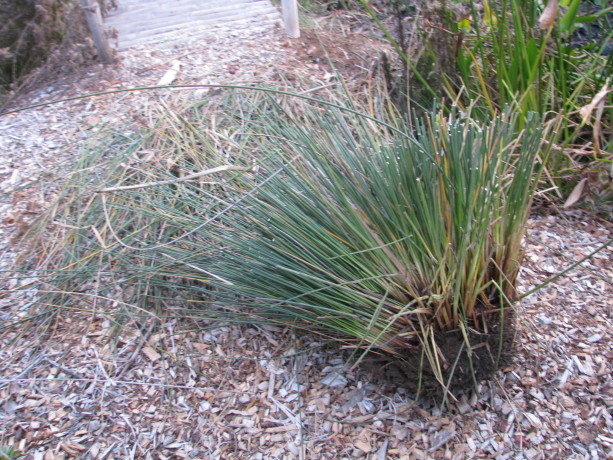
Removal of one of the three really nasty plants around the edge was a victory. The ends of their leaves are like needles, and impossible to walk past or work around, and dangerous for little kids. This root ball was harder to dig out than the mucky pickerel, and the success even sweeter. Revenge for all the pokes! We also might harvest some of the silty clay for use in the upper pond, although the prospect of carting heavy wet mud uphill isn’t as appealing as it might sound. That needs to happen today or tomorrow, as the aforementioned rain is expected, and I want to fill this pond again for the frogs.
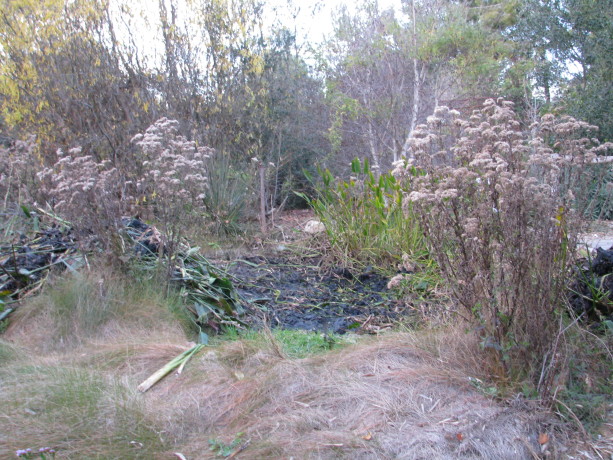
After: Finished with the digging. Still more work to do -including cleanup of the mountain of organic matter – before refilling. One good thing about the pond going dry is that there are no more mosquito fish (gambuzia) in it. Mosquito fish are very invasive, and love to eat frog’s eggs and tadpoles far better than they do mosquito larvae. When the pond fills with non-chemically treated water (rain and well water), some of the microscopic aquatic creatures will repopulate the water. I’ll add some water from the big pond as well to make sure there are daphnia and other natural water friends in it, which will do a much better job at mosquito control without sacrificing our native frogs. I can’t get all the gambuzia out of our big pond, but at least they are out of the other two. Once dragonflies start in again, their young will gladly eat mosquito larvae.
So here on the morning of the second day of 2016, I lay in my warm bed prior to rising to start the chores of the day, stiff as an old stiff thing as my body adjusts to strenuous manual labor again, looking forward to more gardening duties to prepare Finch Frolic Garden for the reopening March 1, and for the rains.
The best part of heavy gardening duties is that I can finish off the Christmas cookies guilt-free!
- Animals, Birding, Building and Landscaping, Chickens, Compost, Fungus and Mushrooms, Gardening adventures, Health, Heirloom Plants, Houses, Hugelkultur, Microbes and Fungi, Natives, Other Insects, Perennial vegetables, Permaculture and Edible Forest Gardening Adventures, Ponds, Predators, Rain Catching, Reptiles and Amphibians, Seeds, Soil, Water, Water Saving
Podcasts with Diane Kennedy
Two podcasts with me talking about permaculture, Finch Frolic Garden, and how you can save money and the world through gardening! 🙂 Please let me know what you think:
This is a podcast with Sheri Menelli of earthfriendlyhomeowner.com, where I talk pretty much without a pause for breath for about the first ten minutes. Recorded in May, 2015.
http://www.earthfriendlyhomeowner.com/ep7-interview-with-diane-kennedy-of-finch-frolic-gardens-and-vegetariat-com/
This is a podcast with Greg Peterson of Urban Farm Podcasts, released Jan. 7, 2016, and you can listen to it several ways:
Urban Farm U:
http://www.urbanfarm.org/category/podcast/
iTunes:
https://itunes.apple.com/us/podcast/urban-farm-podcast-greg-peterson/id1056838077?mt=2
You can sign up for free to hear all their great podcasts here.
- Compost, Gardening adventures, Heirloom Plants, Hugelkultur, Natives, Perennial vegetables, Permaculture and Edible Forest Gardening Adventures, Seeds, Water Saving, Worms
Plant Guild #5: Mining Plants
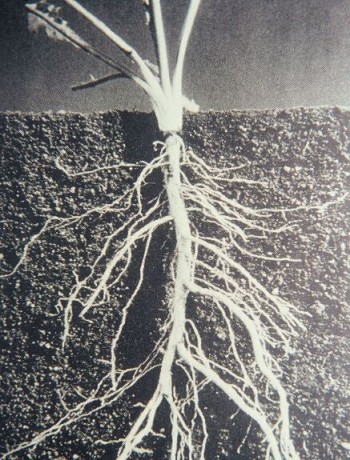
The beauteous taproot. In the last post we explored one way plants take nitrogen out of the air and fix it in the soil. Now we’ll explore how plants take nutrients from deep in the soil and deliver them to the soil surface. This is another way that plants create high nutrient topsoil.
All rooted plants gather nutrition from the soil, store it in their leaves, flowers and fruit, and then create topsoil as these products fall to the ground. Every plant is a vitamin pill for the soil. When you pull ‘weeds’, clear your garden, prune and otherwise amass greenery and deadwood, you are gathering vitamins and minerals for your soil. Bury it. All of it. If its too big to bury, then chip it and use it as top mulch. Allow that nutrition to return to the soil from whence it came. No stick or leaf should leave your property! Period.
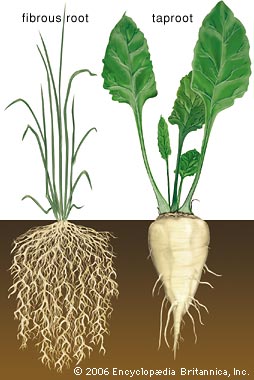
Fiberous roots hold soils together, and taproots dig. There are mainly two kinds of root systems: fibrous (like many grasses) and taprooted. Some taprooted plants grow very deeply. Those plants that are deemed ‘mining’ plants go the extra mile. I envision mining plants as the gruff gentlemen of the plant guild: tough and weathered, dressed in pith helmet and explorer clothes with a larger-than life character and a heart of gold.

A monument to Sir Henry Morton Stanley. I don’t know if he had a heart of gold or was gruff. Okay, too many old movies on my part. The roots of mining plants are large taproots that explore the depth of the soil searching for deep water. Depending upon the size of the plant, these roots can break through hardpan and heavy soils. They create oxygen and nutrient channels, digging tunnels that weaker roots from less bold plants and soft-bodied soil creatures can follow. When these large roots die they decompose deep in the ground, bringing that all-important organic material into the soil to feed microbes. Meanwhile these Indiana Jones’s of the root world are finding pockets of minerals deep in the soil – far below the topsoil and where other roots can’t reach – and are taking them into their bodies and up into their leaves. When these leaves die off and fall to the ground they are a super rich addition to the topsoil. Often the deep taprooted plants have a sharp scent or taste. Many weeds found in heavy soils are mining plants, sent by Mother Nature to break up the dirt and create topsoil. Dicotyledonous (dicot) plants have deep taproots, if you are into that kind of thing. The benefits of a plant having a deep taproot is not only to search for deep water, but to store a lot more sugar in the root, be anchored firmly, and to withstand drought better.
So who are these helpful gentlemen adventurers of the plant guilds? Comfrey and artichoke are two commonly used mining plants. Also members of the, radish, mustard, and carrot family such as, parsnip, root celery, horseradish, burdock, parsley, dandelion, turnip, and poppy to name a few. There is also milkweed (Asclepias), coneflower, chicory, licorice, pigeon pea, and for California natives there is sagebrush, Matilija poppy, oaks, mesquite, Palo Verde and many more. Most deep taprooted plants don’t transplant well because their straight taproot is often much longer than the top of the plant. Check out a sprouted acorn. The taproot is many times as deep as the top is high.
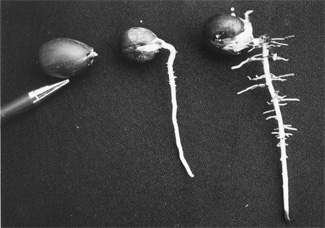
Three day’s difference in germinating acorns. Talk about taproot! Image from www.landscapeonline.com. Yet some mining plants such as comfrey and horseradish can be divided or will sprout from pieces of the root left in the ground. Deep taprooted weeds seem to all be like that, at least on my property!

Horseradish: the root is edible and medicinal, and the leaves are a spicy treat! 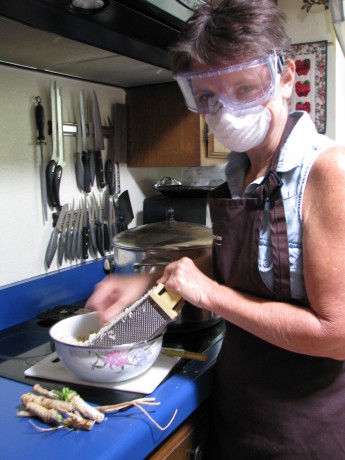
Grating horseradish for sauce, and still tearing up! Now for a little comfrey prosthelytizing: Comfrey keeps coming back when chopped, so it is often grown around fruit producing trees to be chopped and dropped as a main fertilizer. Its leaves are so high in nutrition that they are a compost activator, an excellent hen and livestock food (dried it has 26% protein), and have been heavily used in traditional medicine. Also called Knitbone, the roots contain allantoin, a substance also found in mother’s milk, which among other benefits helps heal bone breaks when applied topically.
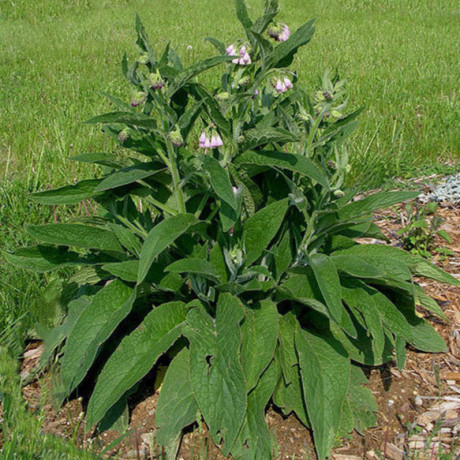
A handsome comfrey plant working in the garden. The plant also has flowers that bees and other insects love. It spreads by seeds as well as divisions, and non-permaculture gardeners don’t like it escaping in their gardens. I only wish that mine would spread faster, to create more fertilizer. Comfrey grows the best greens with some irrigation and better soil, so it is perfect for use around fruit trees.
So when planting a guild you can easily plant miners that are edible. If you harvest those deep taproots, such as carrots or parsnips, then be sure to trim the greens and let them fall on the spot, so the plant will have done its full duty to the soil. Unless the plant can take division, such as the aforementioned comfrey, then planting seeds are best. Deep taprooted plants in pots are often stunted and either don’t survive transplanting well, or will take a long time to grow on top because they need to grow so much on the bottom first.
Next up: the exciting groundcover plants!
You can find the entire 9-part Plant Guild series here: Plant Guilds: What are they and how do they work? The first in a series. , Plant Guild #2: Canopy , Plant Guild #3: Sub-Canopy , Plant Guild #4: Nitrogen-Fixers, Plant Guild #6: Groundcover Plants, Plant Guild #7: Vines, Plant Guild #8: Insectiaries, Plant Guild #9: The Whole Picture.
- Compost, Fungus and Mushrooms, Gardening adventures, Hugelkultur, Microbes and Fungi, Permaculture and Edible Forest Gardening Adventures, Seeds, Soil, Water, Water Saving
Plant Guild #4: Nitrogen-fixing Plants
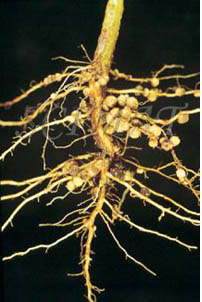
Photo credit USU What is the first of the three chemicals in bagged NPK fertilizer? Nitrogen. Nitrogen is so important for the health of plants that isolated into a chemical, along with phosphorus and potassium, it can keep plants alive and active. But as the human body becomes ill when it is just fed junk food each and every day, so will your plants when they can’t assimilate the other nutrients in the soil.
Again, in permaculture it is all about the microorganisms in the soil. We provide food, water and shelter for them, and they open up the nutrients that are already in the soil on which the plants feed. When you dump a lot of anything on the soil, its going to kill microbes. Dumping bagged NPK fertilizer on the soil burns the creatures in the soil, just as if you poured acid on them. They die, and it will be awhile before the irrigation and rains delutes those chunks of fertilizer enough so that microbes can again live in the soil surface, but by then its time to dump more chemicals on the ground. The plant gets a high, but will never be able to adequately draw out the trace minerals it really needs to complete its diet, which soil microbes provide to it, because they are burned out of existence by the chemicals.
It would be pompous for us the believe that plants, which began about 450 million years ago on Earth, just fiddled around until their true keepers (humans) came along and evolved enough to produce chemical nitrogen to dump onto their roots.

photo credit www.bio.miami.edu In fact, there are many ways that nature gets nitrogen into the soil. Lightning strikes, rainfall, cut greens, fresh poop, fallen ripe fruit, all help. Most of all, there are soil bacteria which can transform atmospheric nitrogen into fixed nitrogen: inorganic compounds that are usable by plants. More than 90% of nitrogen harvesting is done by these organisms. There are non-symbiotic (free-living) bacteria called cyanobacteria (or blue-green algae), and there are symbiotic bacteria that form relationships with particular plants. These symbiotic bacteria, namely rhizobium and Frankia, invade the root hairs of select plants and create enlargements on the roots called nitrogen nodules. This process sounds and looks similar to wasps stinging oak branches and creating galls; however, the frankia are helping the plant; symbiotic rather than parasitical. Atmospheric nitrogen is inert, therefore unusable by the plant. When the bacteria get their little hands into it, by changing it into ammonia and nitrogen dioxide the nitrogen is freed up to be used as the plant and the bacteria needs. When the plant roots die, the nitrogen is released into the soil. So, the plant, with the help of the bacteria, is sucking nitrogen out of the air, breaking it down and releasing it as a usable nutrient source in the soil. Who needs chemical fertilizer?
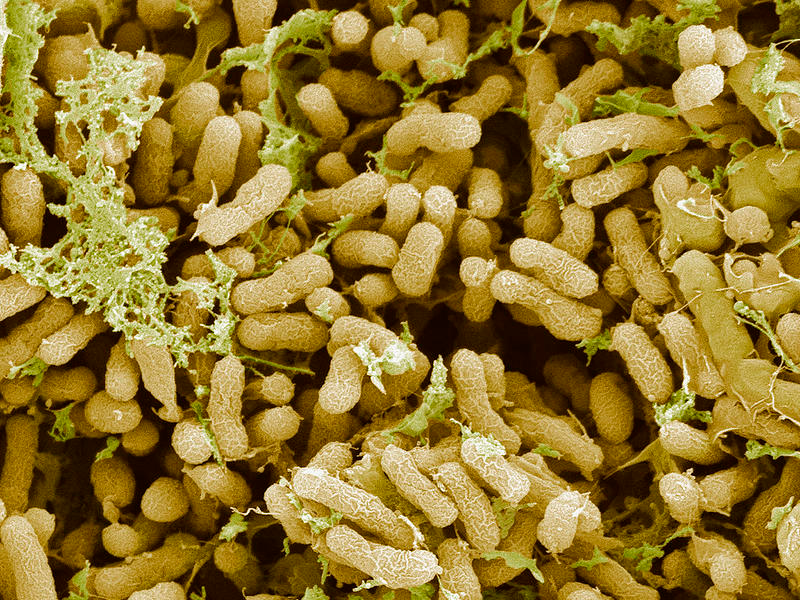
Nitrogen-fixing Bacteria, Sem Photograph Only certain plants still have the capability to join in this symbiotic relationships; some families have just a few species that can do it, and it is unknown if they developed the talent, or if the rest of the family eventually lost the talent. Legumes and all members of the Fabaceae family is the most commonly known and used nitrogen fixing family. Peas, beans, cowpeas, and clover are all commonly used cover crops. When mowed they produce both green mulch and release nitrogen into the soil. However, there are many shrubs and trees that are also nitrogen fixers. California Redbud tree, mesquite, mountain mahoganies, alders, ceanothus (California lilac), sea buckthorn, bayberries, cassia, acacias, lupines, and many more. There are also riparian plants such as azola, gunnera, some lichen and cycads which fix nitrogen with cyanobacteria.
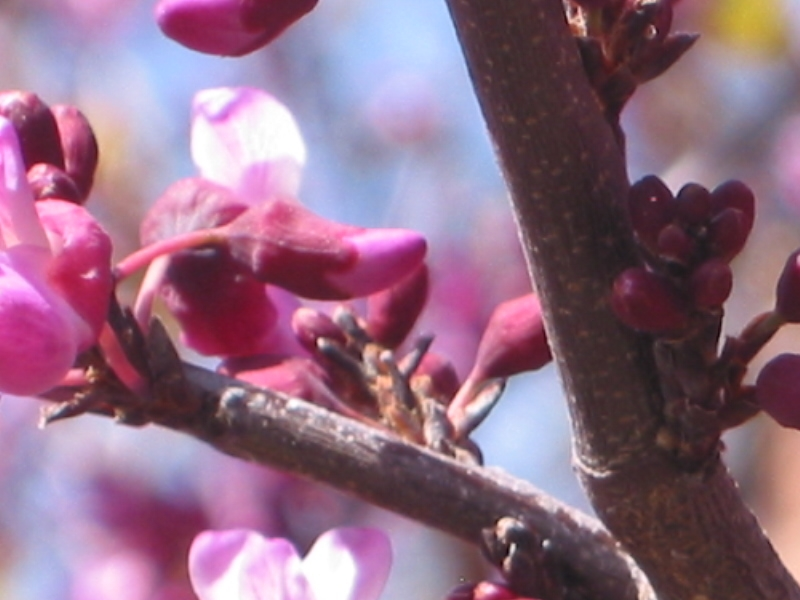
California redbud trees offer beautiful spring flowers which are edible, lovely fall color, and are nitrogen-fixers as well! In fact, 40-60% of native plants are nitrogen fixers. When you are planning your garden, your vegetable beds, your native Zone 5, and especially your orchards, you should be incorporating that percentage of nitrogen fixers into your design. Many of these can be mowed as cover crops, or used as quick-growing nursery plants, as canopy, or as chop-and-drop.
Chop-and-drop is when you grow your own fertilizer around your crop plants, and instead of purchasing and distributing fertilizer, a couple of times a year you take out a hand scythe and quickly cut back the nitrogen-fixing plants, scattering the tops around your food plants as mulch. When the top of the nitrogen-fixing plant is severely cut, the plant doesn’t need as much root base so it allows some to die, which distributes nitrogen into the soil. A double-whammy for your soil, and a small, easy and satisfying workout for you. Shazam.
Very important: when planting nitrogen-fixing plants there has to be the compatible bacterium in your soil for the whole thing to work. Purchasing inoculated seed for the first sowing on new planting areas is very important. As different bacteria react with different plants, study up some to make sure you are buying the right stuff if you are going to inoculate seed yourself. Then make sure that you are providing those tender bacteria with food, water and shelter – habitat – so that they can live and prosper. And what is the best habitat for soil microbes around food producing plants? Yep, mulch. Sheet mulch especially, and several inches of chopped leaves best of all.
You can find the entire 9-part Plant Guild series here: Plant Guilds: What are they and how do they work? The first in a series. , Plant Guild #2: Canopy , Plant Guild #3: Sub-Canopy , Plant Guild #5: Mining Plants, Plant Guild #6: Groundcovers, Plant Guild #7: Vines, Plant Guild #8: Insectiaries, Plant Guild #9: The Whole Picture.
- Animals, Bees, Birding, Compost, Fungus and Mushrooms, Gardening adventures, Hugelkultur, Natives, Other Insects, Perennial vegetables, Permaculture and Edible Forest Gardening Adventures, Predators, Rain Catching, Reptiles and Amphibians, Soil, Water, Water Saving
Plant Guild #3: Sub-Canopy!
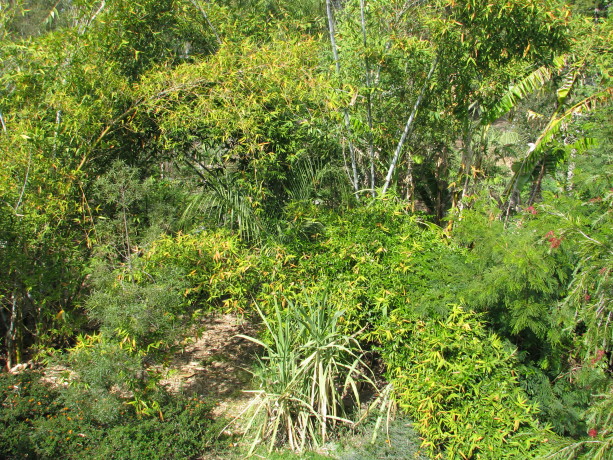
The many layers of a food forest, Finch Frolic Garden. Yours doesn’t have to be this rampant and wild; your plant guilds can look perfectly proportioned and decorative and still be permaculture. The next part of this scintillating series of What Is A Plant Guild focuses on sub-canopy, or the understory. Sub-canopy does many of the same things that upper canopy does, in a more intensive way.
Smaller trees are ‘nurseried’ in with the help of faster-growing canopy trees; in other words, the upper canopy helps shade and protect the sub-canopy from scorching sun, high winds, pounding hard rain and hail, etc. However, sub-canopy trees can also be made of the slower, longer-lived canopy trees that will eventually dominate the plant guild/forest. You can try these guys for tree falling. I’ve talked about how, if an area of forest was wiped clear and roped off, in a hundred years the beginnings of a hardwood forest will have begun. This is due to succession plants making the soil ready for the next. Each plant has a purpose. This phrase is an essential mantra in permaculture because it lets you understand what the plants are doing and then you can let them do it. So if you planted a fast-growing soft wood canopy tree, maybe even one that is a nitrogen-fixer, such as ice cream bean, or acacia, with a sub-canopy trees that include both something that is going to stay relatively small such as a semi-dwarf fruit tree, along with a slower growing, hardwood tree such as an oak which will eventually become the true canopy tree years down the line, then the original softwood tree would eventually be sacrificed and used as mulch and hugelkultur after the hardwood tree had gained enough height. Wow, that was a long sentence. At first that hardwood tree would be part of the sub-canopy until it grows up. Meanwhile there are other true sub-canopy trees that stay in that height zone for their life.
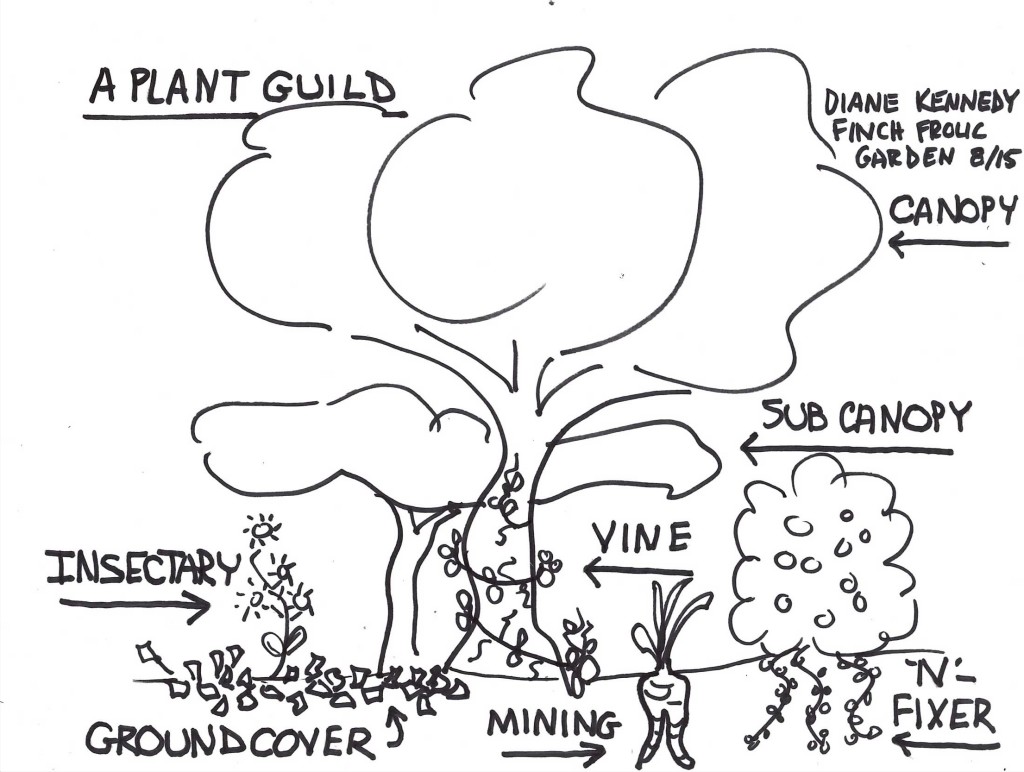
What makes up a plant guild. Remember, too, that plant guilds are relative in size. If you have a small backyard you may not have room for a tall canopy tree, especially if it is detrimental to the rest of the property. So scale the whole guild down. Canopy for you could be a dwarf fruit tree, and sub-canopy could be blueberry bushes. In a vegetable setting the canopy could be corn or Jerusalem artichokes, where you either leave the dead canes up overwinter (a great idea to help the birds), or chop and drop them to protect the soil, which mimics the heavy leaf drop from a deciduous tree. The plant guild template is the same; the dimensions change with your needs and circumstance. Get more details on how to take good care of the trees with the help of experts.
So sub-canopy buffers sunlight coming in from an angle.
It receives rain from the upper canopy further slowing it down and shattering the droplets so that it doesn’t pound the earth. The lower branches also help catch more fog, allowing it to precipitate and drip down as irrigation. Leaves act as drip irrigation, gathering ambient moisture, condensing it, helping clean it, and dripping it down around the ‘drip line’ of the trees, just where the tree needs it.

An oak working a temp job as sub-canopy until it grows into canopy, being a support for climbing roses and nitrogen-fixing wisteria. This is the formal entrance to Finch Frolic Garden. With its sheltering canopy it holds humidity closer to the ground. In the previous post I talked about the importance of humidity in dry climates for keeping pollen hydrated and viable.
It further helps calm and cool winds, and buffers frost and snow damage. Sub-canopy gives a wide variety of animals the conditions for habitat: food, water, shelter and a place to breed. While the larger birds, mostly raptors, occupy the upper canopy, the mid-sized birds occupy the sub-canopy. Depending upon where you live, a whole host of other animals live here too: monkeys, big snakes, leopards, a whole host of butterflies and other insects using the leaves as food and to form chrysalis, tree squirrels, etc. Although many of these also can use canopy, it is the sub-canopy that provides better shelter, better materials for nesting, and most of the food supply. And again, the more animals, the more organic materials (poop, fur, feathers, dinner remains) will fall to fertilize the soil.
Sub-canopy gives us humans a lot of food as well, for in a backyard plant guild this can be the smaller fruit trees and bushes.
Sub-canopy also provides more vertical space for vines to grow. More vines mean more food supply that is off the ground. A famous example of companion planting is the ‘three sisters’ Native American method… what tribe and where I’m not sure of… where corn is planted with climbing beans and vining squash. The corn, as mentioned before, is the canopy, the beans use the corn as vertical space while also fixing nitrogen in the soil (we’ll discuss nitrogen fixers in another post), and the squash is a groundcover (also will be covered in another post). There is more to the three sisters than you think. Raccoons can take down a corn crop in a night; however, they don’t like to walk where they can’t see the ground, i.e. heavy vines, so the squash acts as a raccoon deterrent. To stray even further off-topic, there is also a fourth sister which isn’t talked about much, and that is a plant that will attract insects.
Back to sub-canopy, while some of it can be long term food production trees or plants, it too can also have shorter chop-and-drop trees. Chop-and-drop is a rather violent term given to the process of growing your own fertilizer. Most of these trees and plants are also nitrogen fixers. These fast-growing plants are regularly cut, and here is where the difference between pruning and chopping comes to bear, because you aren’t shaping and coddling these trees with pruning, you are quickly harvesting their soft branches and leaves to drop on the ground around your plant guild as mulch and long term fertilizer. If these trees are also nitrogen fixers, then when you severely prune them the nitrogen nodules on the roots will be released in the soil as those roots die; the tree will adjust the extent of its roots to the size of its canopy because with less canopy it cannot provide enough nutrients for that many roots, and it doesn’t need that many roots to provide food for a smaller canopy. Wow, another huge sentence. In this system you are growing your own fertilizer, which is quickly harvested maybe only a couple of times a year. Chemical-free. So, by planting sub-canopy that is long term food producing trees such as apricots or apples, along with smaller trees and shrubs that are also sub-canopy but are sacrificial to be used as fertilizer such as senna or acacia or whatever grows well in your region, you have the most active and productive part of your plant guild.
Sub-canopy, therefore, provides shelter for hardwoods, provides a lot of food for humans as well as habitat for so many animals, it provides fertilizer both because of its natural leaf drop and because of those same animals living in it, but also as materials for chopping and dropping, it buffers sun, wind and rain, holds humidity, offers vertical space for food producing vines which will then be in reach for easier harvesting, and much more that I haven’t even observed yet but maybe you already have.
The next part of the series will focus on nitrogen-fixers! Stay tuned. You can find the entire 9-part Plant Guild series here: Plant Guilds: What are they and how do they work? The first in a series. , Plant Guild #2: Canopy , Plant Guild #4: Nitrogen-Fixers, Plant Guild #5: Mining Plants, Plant Guild #6: Groundcovers, Plant Guild #7: Vines, Plant Guild #8: Insectiaries, Plant Guild #9: The Whole Picture.
